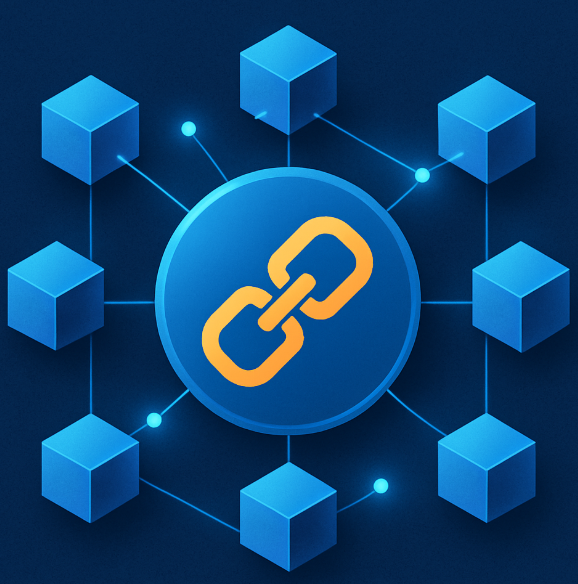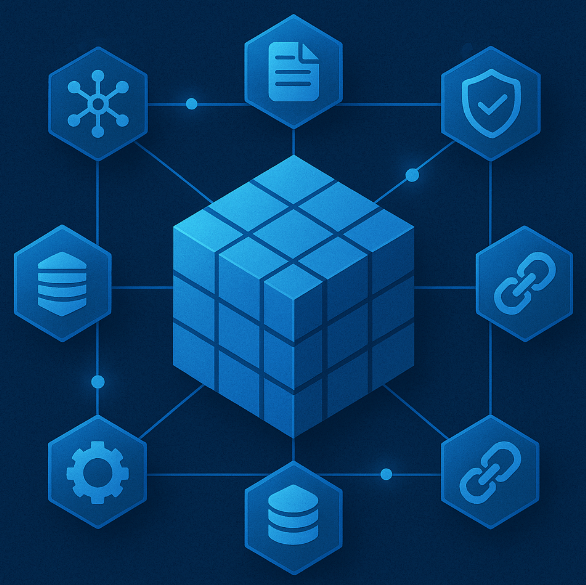Main > Blog > , You are here
In today's world of digital technologies, we are constantly encountering new terms. One such term that has sparked a true revolution not only in finance but also in many other industries is blockchain. You may have heard this word in the context of cryptocurrencies like Bitcoin, but its meaning and potential are much broader. For many, this concept still seems complex and confusing. The purpose of this article is to explain what blockchain is in simple terms, how it works, and why this technology is the future.
Our goal is to break it all down so that everyone, even those furthest from technology, can understand the essence of this phenomenon. We will explore what the blockchain system is, how transactions are added to it, and what makes it so secure.
What is Blockchain? An Analogy with a Digital Notebook
Let's imagine a regular notebook. In it, you write down all your important tasks or, say, money transfers. Now, imagine that this notebook is not unique but exists in thousands of identical copies, and each copy is held by different people around the world.
When someone wants to add a new entry (for example, "Anna sent 10 coins to Boris"), they announce it to all the notebook owners. All participants check if Anna actually has these 10 coins, and if everything is correct, they add this entry to their copies.
Blockchain is, in essence, such a digital, decentralized notebook, or as it is also called, a distributed ledger. It consists of a chain of blocks, where each block is a page with records. Once a page is full, it is "stitched" to the previous ones, forming a continuous chain. Most importantly, it is nearly impossible to change or delete an entry retroactively in such a notebook. Any attempt at fraud will be immediately noticed and rejected by all other network participants.
So, to answer the question "what is blockchain" as simply as possible, it is a shared, constantly synchronized database, protected by cryptography and stored simultaneously on many computers.
How Blockchain Works: Blocks, Chains, and Transactions
To truly understand how this technology functions, you need to understand its key components. Blockchain technology is based on three pillars: blocks, the chain, and a decentralized network.

Blocks
Each block in the chain can be compared to a page in our digital ledger. It contains three main elements:
Data: This primarily includes blockchain transactions. For example, information about fund transfers between users. A single block can contain several hundred or even thousands of such transactions.
Hash: This is a unique digital signature of the block, similar to a fingerprint. It is generated based on the data inside the block. If even one character in the data is changed, the hash will change completely.
Hash of the previous block: This is the "hook" that links the current block to the previous one. It is the presence of the previous block's hash that creates a continuous and unbreakable chain. The first block in a chain, called the "genesis block," does not contain such a hash.
The Chain
Linking blocks via hashes makes the blockchain incredibly secure. Imagine an attacker wants to alter a transaction in block #100. As soon as they do, the hash of block #100 will change. This, in turn, will cause a mismatch with the hash recorded in block #101. The chain will "break." To hide their tampering, the fraudster would have to recalculate the hashes of all subsequent blocks (101, 102, 103, and so on), which requires colossal computational power.
The Decentralized Network
This is where the main secret to its security lies. All of this happens not on a single central server, but on a decentralized (peer-to-peer) network where each participant (node) has a full or partial copy of the entire blockchain. How are transactions added to the blockchain? When a new block is created, it is broadcast to all network participants. They conduct a blockchain verification: they check if the new block follows the system's rules and if anyone is trying to cheat the network. If the majority of participants confirm that the block is legitimate, it is added to their copies of the chain. Forging data on one computer is pointless, as the other thousands of copies will remain unchanged and immediately expose the fraud.
Blockchain in Crypto is the Heart of the System
Now it becomes clearer what blockchain is in cryptocurrency. Cryptocurrencies like Bitcoin or Ethereum were the first and most famous application of this technology. Blockchain in crypto is the very ledger that tracks all transactions and ownership of coins.

When you send crypto assets to someone or start a cryptocurrency exchange, you are essentially creating a request to add a new transaction to the blockchain. Miners (in networks like Bitcoin) or validators (in other systems) compete for the right to add a new block with your and other transactions to the chain, receiving a reward in the form of cryptocurrency. This incentivizes them to maintain the network's operation and security.
Your Key to the Crypto World: The Blockchain Wallet
If you want to interact with the blockchain—send or receive cryptocurrency—you will need a special tool. And that is a blockchain wallet. It's important to understand that a blockchain wallet doesn't actually store your coins inside it like a regular wallet holds cash. Your assets always reside on the blockchain itself.
A blockchain wallet is a program that stores your "keys":
Public Key (address): This is like your bank account number. You can safely share it with others to receive funds.
Private Key: This is your secret password. It is used to sign transactions and proves that you are the owner of the funds at a specific address. Never, under any circumstances, share your private key with anyone! If you lose it, you will permanently lose access to your money.
There are various types of wallets: software (for PC and smartphones), hardware (in the form of USB devices), and even paper wallets. The choice depends on your needs for convenience and security.
What Keeps the Blockchain Honest and Free?
We have already established that blockchain technology is secured by cryptography and decentralization. But what makes all participants play by the rules? What keeps the blockchain honest and free is a combination of several factors:
Transparency: On most (public) blockchains, all transactions are visible to everyone. You don't see names, only wallet addresses, but you can trace any transfer from start to finish.
Immutability: Once information is recorded on the blockchain, it cannot be altered or deleted. This creates absolute trust in the data.
Consensus: Before a new block is added to the chain, a majority of the network's participants must reach an agreement (consensus) that it is valid. The most well-known consensus algorithms are Proof-of-Work, which requires computational power, and Proof-of-Stake, where the right to create a block depends on the number of coins a validator holds.
This system makes it virtually impossible for one person or group to control the network or commit fraud. To take control of the Bitcoin network, for example, one would need more computing power than all other network participants combined, which is economically infeasible.
Public, Private, and More: The Different Faces of Blockchain
It's important to know that blockchain technologies are not limited to one type. There are different kinds of blockchains created for different purposes.
What is a Public Blockchain?
This is the classic and most well-known type of blockchain. Bitcoin and Ethereum are prime examples. Key features:
Openness: Anyone can join the network, view the ledger, and participate in the transaction validation process.
Decentralization: There is no single controlling entity.
Anonymity (Pseudonymity): Participants are hidden behind their wallet addresses.
What is a public blockchain? It's a system without borders or censorship, accessible to all.
What is a Private Blockchain?
This type of blockchain is often used in the corporate sector.
Restricted Access: The network is closed, and one must receive permission from an administrator to become a participant.
Centralization (Partial): Access levels and participant rights are controlled by one or more organizations.
High Speed and Confidentiality: Since there are fewer participants and they are known, transactions are confirmed much faster, and data remains confidential.
What is a private blockchain? It's a corporate database with the benefits of blockchain, such as security and traceability, but in a controlled environment.
There are also hybrid and consortium blockchains that combine features of public and private networks.
Who Created Blockchain? A Brief History
Although blockchain became famous thanks to Bitcoin in 2009, its conceptual foundations were laid much earlier. Back in 1991, scientists Stuart Haber and W. Scott Stornetta described a cryptographically secured chain of blocks as a way to protect digital documents from tampering.
However, the person or group of people under the pseudonym Satoshi Nakamoto breathed real life into this technology. It was Nakamoto who, in 2008, published the whitepaper describing Bitcoin, where a fully functional blockchain system as we know it today was first proposed. Who created blockchain for cryptocurrencies? The answer is Satoshi Nakamoto, whose identity remains one of the greatest mysteries of the digital age.
More Than Just Cryptocurrency
We have tried to explain what blockchain is in simple terms. It's not just a technology for creating digital money. It is a fundamentally new way of storing, verifying, and transferring information, based on the principles of transparency, security, and decentralization.
The potential of blockchain technology is enormous: from creating secure voting systems and supply chain management to protecting copyrights and maintaining medical records. We are only at the beginning of a new era, and understanding the basics of blockchain today is the key to understanding the world of tomorrow. We hope that now when you hear the word blockchain, you see not complex code, but that simple and brilliant idea of a shared digital notebook capable of changing the world.
